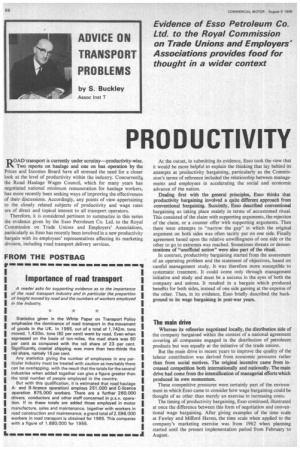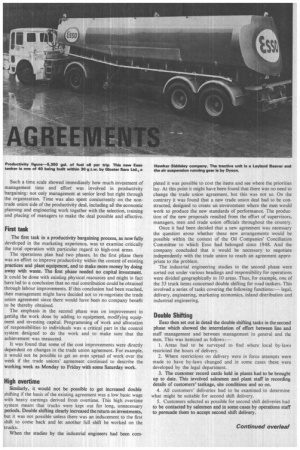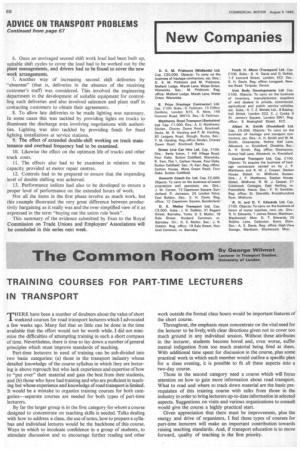PRODUCTIVITY
Page 68

Page 69

Page 70

If you've noticed an error in this article please click here to report it so we can fix it.
DOAD transport is currently under scrutiny—productivity-wise. Two reports on haulage and one on bus operation by the Prices and Incomes Board have all stressed the need for a closer look at the level of productivity within the industry. ConcurrentlN the Road Haulage Wages Council, which for many years has negotiated national minimum remuneration for haulage workers, has more recently been seeking ways of improving the effectiveness of their discussions. Accordingly, any points of view appertaining to the closely related subjects of productivity and wage rates are of direct and topical interest to all transport operators. Therefore, it is considered pertinent to summarize in this series the evidence given by the Esso Petroleum Co. Ltd. to the Royal Commission on Trade Unions and Employers' Associations, particularly as Esso has recently been involved in a new productivity bargain with its employees' representatives affecting its marketing division, including road transport delivery services. At the outset, in submitting its evidence, Esso took the view that it would be more helpful to explain the thinking that lay behind its attempts at productivity bargaining, particularly as the Commission's terms of reference included the relationship between managements and employees in accelerating the social and economic advance of the nation.
Dealing first with the general principles, Esso thinks that productivity bargaining involved a quite different approach from conventional bargaining. Suecintly, Esso described conventional bargaining as taking place mainly in terms of accustomed ritual. This consisted of the claim with supporting arguments, the rejection of the claim, or a counter offer with supporting arguments. Then there were attempts to "narrow the gap" in which the original argument on both sides was often tacitly put on one side. Finally agreement based upon the relative unwillingness of one side or the other to go to extremes was reached. Sometimes threats or demonstrations of "unofficial action" were also part of the ritual.
In contrast, productivity bargaining started from the assessment of an operating problem and the statement of objectives, based on careful management study. It was therefore more susceptible to systematic treatment. It could come only through management initiative and study and must be a success in the eyes of both the company and unions. It resulted in a bargain which produced benefits for both sides, instead of one side gaining at the expense of the other. Then, in its evidence, Esso briefly described the background to its wage bargaining in post-war years.
The main drive Whereas its refineries negotiated locally, the distribution side of the company bargained within the context of a national agreement covering all companies engaged in the distribution of petroleum products but was equally at the initiative of the trade unions.
But the main drive in recent years to improve the quality of the labour contribution was derived from economic pressures rather than from social motives. The original incentive came from increased competition both internationally and nationally. The main drive had come from the intensification of managerial efforts which produced its own momentum.
These competitive pressures were certainly part of the environment in which Esso came to consider how wage bargaining could be thought of as other than merely an exercise in increasing costs.
The timing of productivity bargaining, Esso continued, illustrated at once the difference between this form of negotiation and conventional wage bargaining. After giving examples of the time scale at Fawley and Milford Haven, the time scale when applied to the company's marketing exercise was from 1962 when planning started until the present implementation period from February to August. Such a time scale showed immediately how much investment of management time and effort was involved in productivity bargaining: not only management at senior level but right through the organization. Time was also spent concurrently on the nontrade union side of the productivity deal, including all the economic planning and engineering work together with the selection, training and placing of managers to make the deal possible and effective.
Fimt task
The first task in a productivity bargaining process, as now fully developed in the marketing experience, was to examine critically the total operation with particular regard to high-cost areas.
The operations plan had two phases. In the first phase there was an effort to improve productivity within the context of existing practices and plant equipment, and to make more money by doing away with waste. The first phase needed no capital investment. It could be done with existing physical resources and might in fact have led to a conclusion that no real contribution could be obtained through labour improvements. If this conclusion had been reached, then management might have decided not to re-negotiate the trade union agreement since there would have been no company benefit to be thereby obtained.
The emphasis in the second phase was on improvement in getting the work done by adding to equipment, modifying equipment and investing capital. Programming of work and allocation of responsibilities to individuals was a critical part in the control system designed to do the work and to make sure that the achievement was measured.
It was found that some of the cost improvements were directly dependent on changes in the trade union agreement. For example, it would not be possible to get an even spread of work over the week if the trade unions' agreement continued to describe the working week as Monday to Friday with some Saturday work.
High overtime
Similarly, it would not be possible to get increased double shifting if the basis of the existing agreement was a low basic wage with heavy earnings derived from overtime. This high overtime system meant that trucks were kepi out for long, unnecessary periods. Double shifting clearly increased the return on investments, but it was not possible unless there was an inducement to the first shift to come back and let another full shift be worked on the trucks.
When the studies by the industrial engineers had been corn pleted it was possible to cost the items and see where the priorities lay. At this point it might have been found that there was no need to change the trade union agreement, but this was not so. On the contrary it was found that a new trade union deal had to be constructed, designed to create an environment where the men would work to produce the new standards of performance. The production of the new proposals resulted from the effort of supervisors, managers, men and trade union officials throughout the country.
Once it had been decided that a new agreement was necessary the question arose whether these new arrangements would be possible within the context of the Oil Companies' Conciliation Committee to which Esso had belonged since 1948. And the company concluded that it would be necessary to negotiate independently with the trade union to reach an agreement appropriate to the problem.
The industrial engineering studies in the second phase were sorted out under various headings and responsibility for operations were divided geographically in 10 areas. Thus, for example, one of the 33 truck items concerned double shifting for road tankers. This involved a series of tasks covering the following functions:— legal, delivery, engineering, marketing economics, inland distribution and industrial engineering.
Double Shifting
Esso then set out in detail the double shifting tasks in the second phase which showed the interrelation of effort between line and staff management and between management in general and the men. This was itemized as follows:— 1. Areas had to be surveyed to find where local by-laws restricted the hours of delivery.
2. Where restrictions on delivery were in force attempts were made to have by-laws changed and in some cases these were developed by the legal department.
3. The customer record cards held in plants had to be brought up to date. This involved salesmen and plant staff in recording details of customers' tankage, site conditions and so on.
4. All customers' deliveries had to be examined to determine what might be suitable for second shift delivery.
5. Customers selected as possible for second shift deliveries had to be contacted by salesmen and in some cases by operations staff to persuade them to ac,cept second shift delivery. 6. Once an envisaged second shift work load had been built up, suitable shift cycles to cover the load had to be worked out by the plant managements, and drivers had to be found to cover the new work arrangements.
7_ Another way of increasing second shift deliveries by "absentee" (that is, deliveries in the absence of the receiving customer's staff) was considered. This involved the engineering department in the development of suitable equipment for controlling such deliveries and also involved salesmen and plant staff in contacting customers to obtain their agreements.
8. To allow late deliveries to be made lighting was necessary. In some cases this was tackled by providing lights on trucks to illuminate the discharge area involving negotiations with authorities. Lighting was also tackled by providing funds for fixed Lighting installations at service stations.
9. The effect of extended double-shift working on truck maintenance and overhaul frequency had to be examined.
10. Likewise the effect on the optimum life of trucks and other truck costs.
11. The effects also had to be examined in relation to the capacity provided at motor repair centres.
12. Controls had to be prepared to ensure that the impending level of double shifting was achieved.
13. Performance indices had also to be developed to ensure a proper level of performance on the extended hours of work.
Not all the items in the first phase involve as much work, but this example illustrated the very great difference between productivity bargaining as it really was and the over-simplified view of it as expressed in the term "buying out the union rule book".
This summary of the evidence submitted by Esso to the Royal Commission on Trade Unions and Employers' Associations will be concluded in this series next week.
















































































































